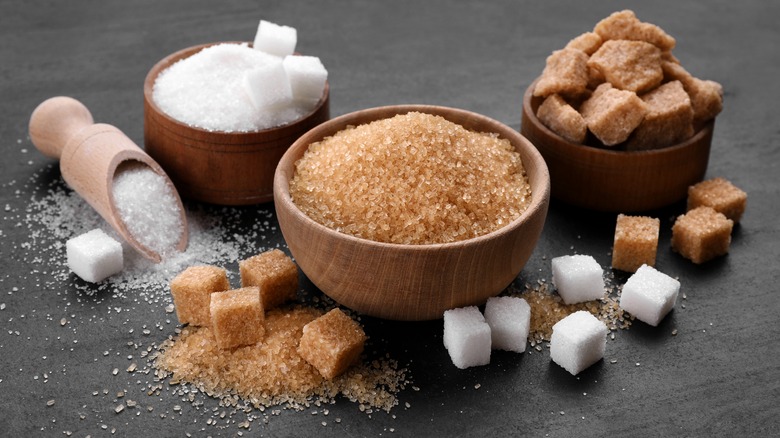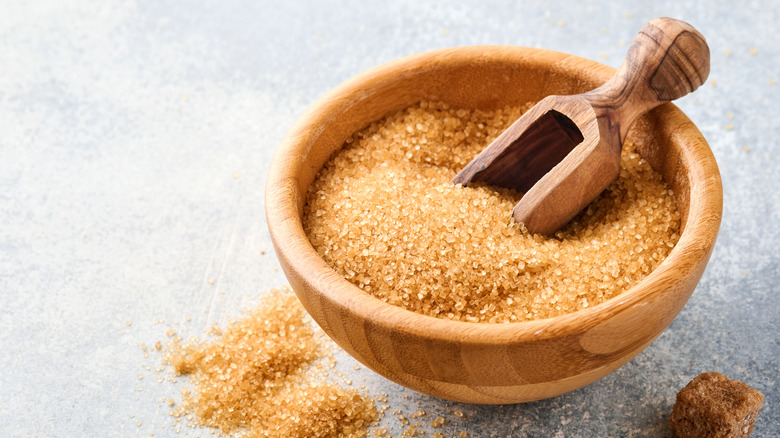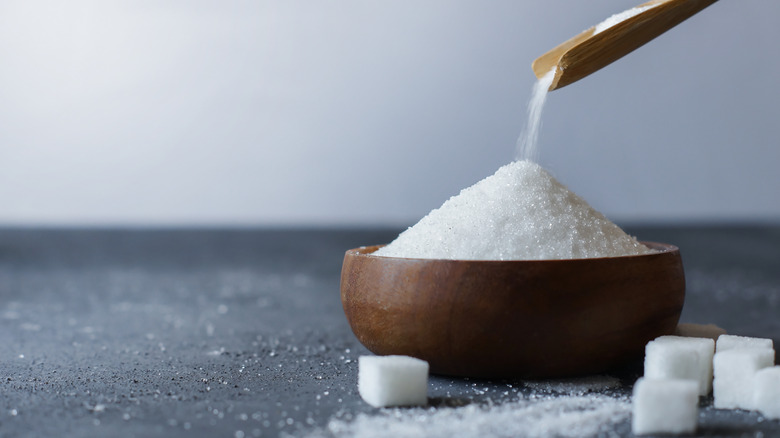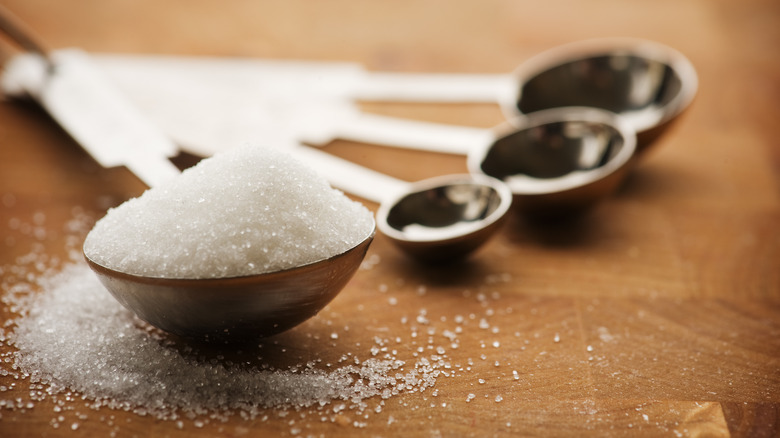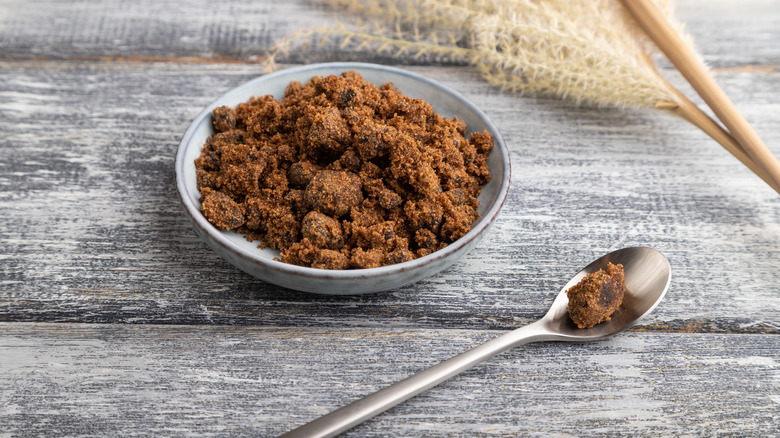Here's What Sets Cane Sugar Apart From Granulated
Sugar — just the word alone brings on so many associations. It's indispensable to our modern diet, fundamental to a wide range of dishes. At certain times in history, it was a prized commodity that fueled politics but it is now easily accessible on grocery shelves worldwide.
It can be surprising just how many types of sugar are available today. From brown sugar, to confectioners', caster, and turbinado, it's easy to get lost in the nuance of the sweet stuff. Yet examining the different processing methods and flavor palates can be incredibly helpful in enhancing culinary applications.
Just take a look at cane sugar — the term refers to any crystallized product that comes exclusively from the tall, sweet grass. This includes everything from the dark caramel notes of jaggery, to the powdered sugar on a donut. Based on its name, granulated sugar may sound similar; however, it's actually a reference to a more specific refined and crystallized sugar type, that many refer to as simply white sugar. With such distinct characteristics, there's lots of additional complexity that sets the two sugars apart.
What is cane sugar?
Cane sugar refers to the many varying sugar types produced specifically from the sugar cane plant (Saccharum officinarum). This nomenclature serves to distinguish products made from only beet sugar, and beet-cane sugar medleys.
After harvest, all cane sugars follow a similar production process. First, the tall stalks are cut and pulverized to extract the sugary juice. This liquid is then clarified and concentrated with heat, greatly increasing its sucrose density. It then goes through a crystallization process, producing variously refined sugars, and three different types of molasses, which are a byproduct.
Depending on the amount of this dark, smoky molasses that's left in processing, cane sugar is classified into different types. There's the least refined version, which comes in the form of muscovado, piloncillo, or jaggery, each of which is interlinked with a certain region. While they take on different consistencies, all are united by dark tint and rich flavor.
The next phase of refinement is called raw sugar, which has a coarse texture, but is noticeably lighter in tint. This type includes demerara and turbinado sugar which are both celebrated for their rich flavor. Finally, cane sugar can also be refined to a completely white coloration, which includes beloved staples like granulated and confectioners' sugar. Sometimes, coarse sugars with medium molasses flavors are labeled as cane sugar, but it's not a definitive categorization.
What is granulated sugar?
You're likely already familiar with granulated sugar, you just don't refer to it by this more specified name. Granulated sugar is employed in baking, mixing into drinks, and many other cooking applications. If a recipe calls for a basic sugar, this is the type you'll reach for. This popular type is made from either beets or sugar cane, with an intensive refinement process resulting in an uniform result.
Granulated sugar is different from demerara and other raw sugars due to an extra processing step. These darker sugars are liquified, centrifuged and crystallized one additional time to form this product. This refinement step can take place at an additional facility, oftentimes outside of the country, so granulated sugar doesn't possess any regional qualities.
The result is then ground to various textures. There are a few distinctions between such consistencies; fine granulated sugar goes by caster sugar, while a coarser, clumped variety is called pearl sugar. Most granulated sugars fall in between such a range, but there might be some slight textural deviations depending on the brand and location. However, what's guaranteed is a dependably neutral flavored sugar that's easy to use.
Granulated sugar's consistency makes it a culinary favorite
The uniform nature of granulated sugar makes it a preferred option for complex cooking applications. In addition to the fact the label refers to a more specific size, color, and flavor, these sugar crystals also come with other advantages.
First, white sugar has a much more simple chemical constituency — it's exclusively sucrose. Such a chemical formula also makes it best in reactions like baking, because this composition empowers the best yeast-rising capabilities. So use it in any doughy recipes to minimize the possibility of a poor leavening process.
Plus, granulated sugar's more uniform textures means it dissolves more evenly. This makes it a favorite for syrups, like in a simple no heat simple syrup recipe, as it forms a nice consistency with less irregularities. And it furthers its appeal in baked applications, ensuring that your family's beloved cookie recipes always turn out the same. Lastly, granulated sugar's white color ensures there's no caramel off-coloring, which can be an issue in cocktail and drink-making. When you want to maintain consistency with every batch, granulated sugar is the right call.
Cane sugars lend a specific flavor to dishes
Of course, there's merit to dependability, but sometimes foods can benefit from a sweet flavorful flourish. With its large range of processing methods, cane sugar lends for an expansive palate. Its richer taste can add additional complexity to a dish, without involving other ingredients. Especially when it comes to unrefined cane sugars, there's a rich cultural tradition to rely on.
Take piloncillo, a Mexican favorite, this less-processed cane sugar type is molded into a cone. The product has an intricate taste that offers smoke, caramel, and even liquor-like notes. It's an unmistakable flavor in a velvety champurrado drink or a Capirotada, a classic Mexican dessert reminiscent of bread pudding. These recipes would lose their flair with another sugar type, making this cane sugar type essential.
Additionally, there's the moist, and molasses-heavy muscovado, which brings a richness to dishes that's hard to replicate. You can add muscovado sugar for a richer, caramelized barbecue sauce or for a delectable muscovado chocolate ganache. And there's distinct qualities to more processed sugars, too — which might simply be sold under the cane sugar name. Although a little harder to bake with, reach for these over granulated to enhance the taste of sugar cookies or pralines. It's in such nuanced, yet important distinctions that all the sugar types shine; their intricacies are not to be overlooked.
